sensor BMW 328I XDRIVE 2013 User Guide
[x] Cancel search | Manufacturer: BMW, Model Year: 2013, Model line: 328I XDRIVE, Model: BMW 328I XDRIVE 2013Pages: 242, PDF Size: 5.38 MB
Page 102 of 242
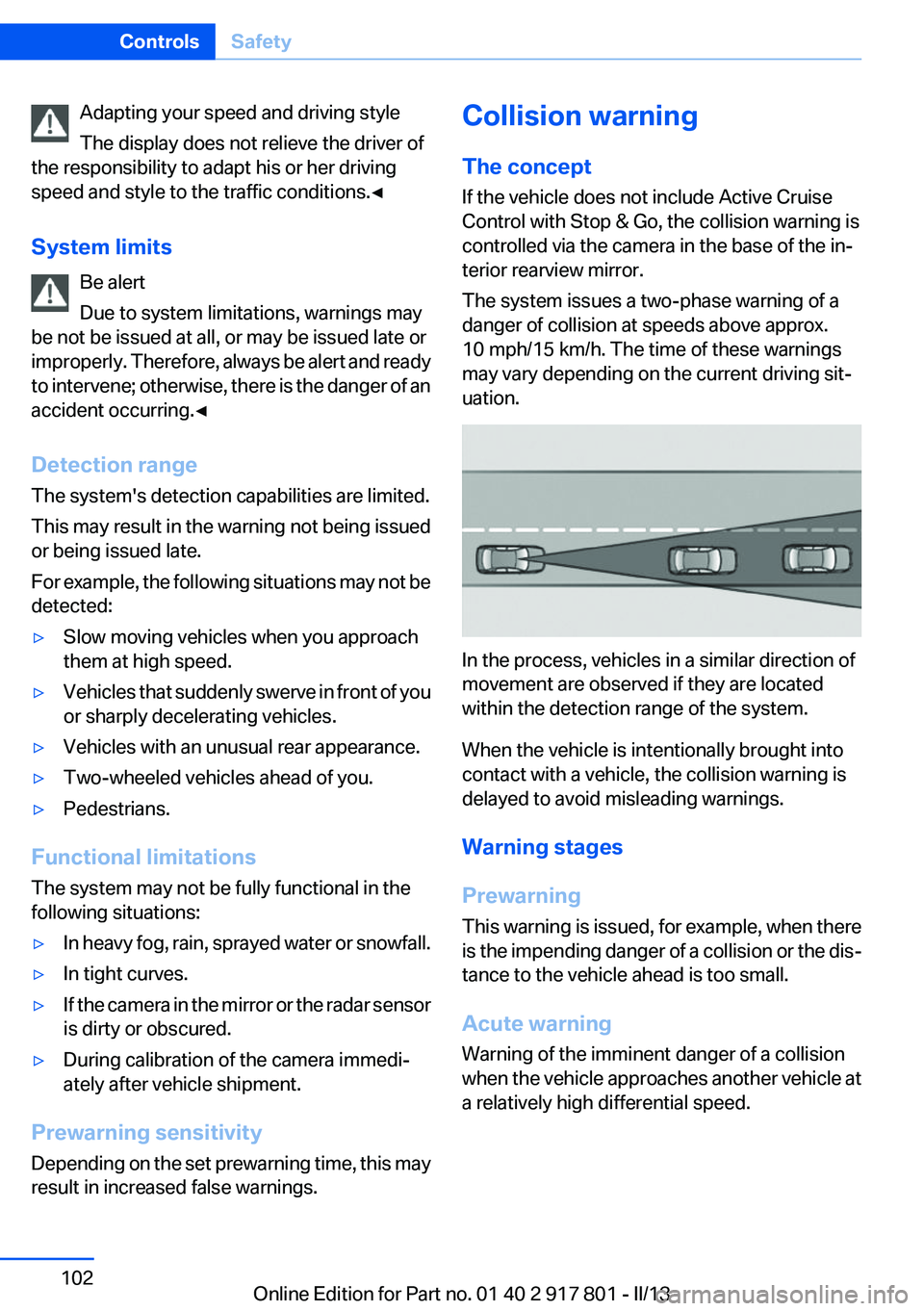
Adapting your speed and driving style
The display does not relieve the driver of
the responsibility to adapt his or her driving
speed and style to the traffic conditions.‚óÄ
System limits Be alert
Due to system limitations, warnings may
be not be issued at all, or may be issued late or
improperly. Therefore, always be alert and ready
to intervene; otherwise, there is the danger of an
accident occurring.‚óÄ
Detection range
The system's detection capabilities are limited.
This may result in the warning not being issued
or being issued late.
For example, the following situations may not be
detected:‚Ė∑Slow moving vehicles when you approach
them at high speed.‚Ė∑Vehicles that suddenly swerve in front of you
or sharply decelerating vehicles.‚Ė∑Vehicles with an unusual rear appearance.‚Ė∑Two-wheeled vehicles ahead of you.‚Ė∑Pedestrians.
Functional limitations
The system may not be fully functional in the
following situations:
‚Ė∑In heavy fog, rain, sprayed water or snowfall.‚Ė∑In tight curves.‚Ė∑If the camera in the mirror or the radar sensor
is dirty or obscured.‚Ė∑During calibration of the camera immedi‚Äź
ately after vehicle shipment.
Prewarning sensitivity
Depending on the set prewarning time, this may
result in increased false warnings.
Collision warning
The concept
If the vehicle does not include Active Cruise
Control with Stop & Go, the collision warning is
controlled via the camera in the base of the in‚Äź
terior rearview mirror.
The system issues a two-phase warning of a
danger of collision at speeds above approx.
10 mph/15 km/h. The time of these warnings
may vary depending on the current driving sit‚Äź
uation.
In the process, vehicles in a similar direction of
movement are observed if they are located
within the detection range of the system.
When the vehicle is intentionally brought into
contact with a vehicle, the collision warning is
delayed to avoid misleading warnings.
Warning stages
Prewarning
This warning is issued, for example, when there
is the impending danger of a collision or the dis‚Äź
tance to the vehicle ahead is too small.
Acute warning
Warning of the imminent danger of a collision
when the vehicle approaches another vehicle at
a relatively high differential speed.
Seite 102ControlsSafety102
Online Edition for Part no. 01 40 2 917 801 - II/13
Page 105 of 242
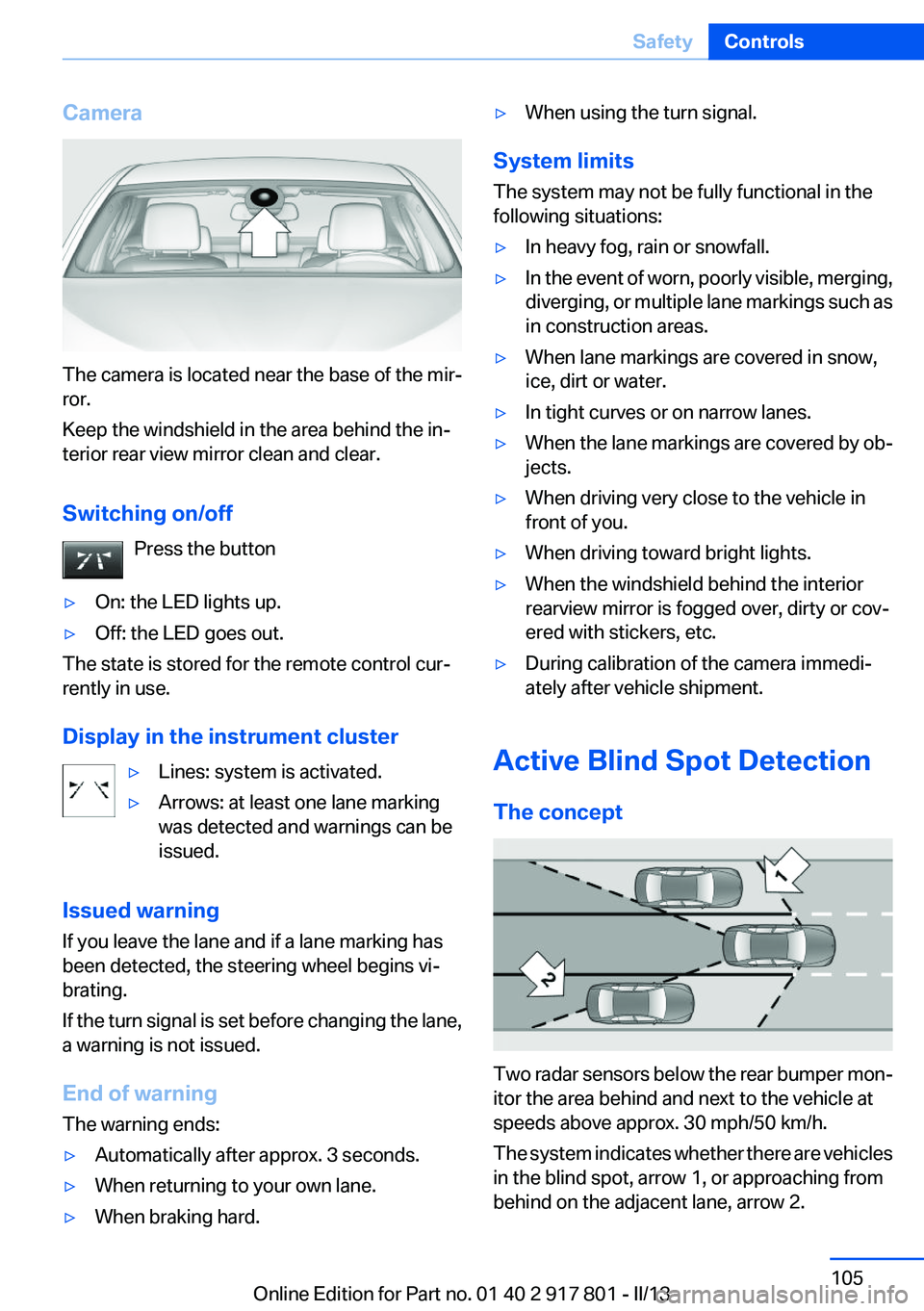
Camera
The camera is located near the base of the mir‚Äź
ror.
Keep the windshield in the area behind the in‚Äź
terior rear view mirror clean and clear.
Switching on/off Press the button
‚Ė∑On: the LED lights up.‚Ė∑Off: the LED goes out.
The state is stored for the remote control cur‚Äź
rently in use.
Display in the instrument cluster
‚Ė∑Lines: system is activated.‚Ė∑Arrows: at least one lane marking
was detected and warnings can be
issued.
Issued warning
If you leave the lane and if a lane marking has
been detected, the steering wheel begins vi‚Äź
brating.
If the turn signal is set before changing the lane,
a warning is not issued.
End of warning
The warning ends:
‚Ė∑Automatically after approx. 3 seconds.‚Ė∑When returning to your own lane.‚Ė∑When braking hard.‚Ė∑When using the turn signal.
System limits
The system may not be fully functional in the
following situations:
‚Ė∑In heavy fog, rain or snowfall.‚Ė∑In the event of worn, poorly visible, merging,
diverging, or multiple lane markings such as
in construction areas.‚Ė∑When lane markings are covered in snow,
ice, dirt or water.‚Ė∑In tight curves or on narrow lanes.‚Ė∑When the lane markings are covered by ob‚Äź
jects.‚Ė∑When driving very close to the vehicle in
front of you.‚Ė∑When driving toward bright lights.‚Ė∑When the windshield behind the interior
rearview mirror is fogged over, dirty or cov‚Äź
ered with stickers, etc.‚Ė∑During calibration of the camera immedi‚Äź
ately after vehicle shipment.
Active Blind Spot Detection
The concept
Two radar sensors below the rear bumper mon‚Äź
itor the area behind and next to the vehicle at
speeds above approx. 30 mph/50 km/h.
The system indicates whether there are vehicles
in the blind spot, arrow 1, or approaching from
behind on the adjacent lane, arrow 2.
Seite 105SafetyControls105
Online Edition for Part no. 01 40 2 917 801 - II/13
Page 106 of 242
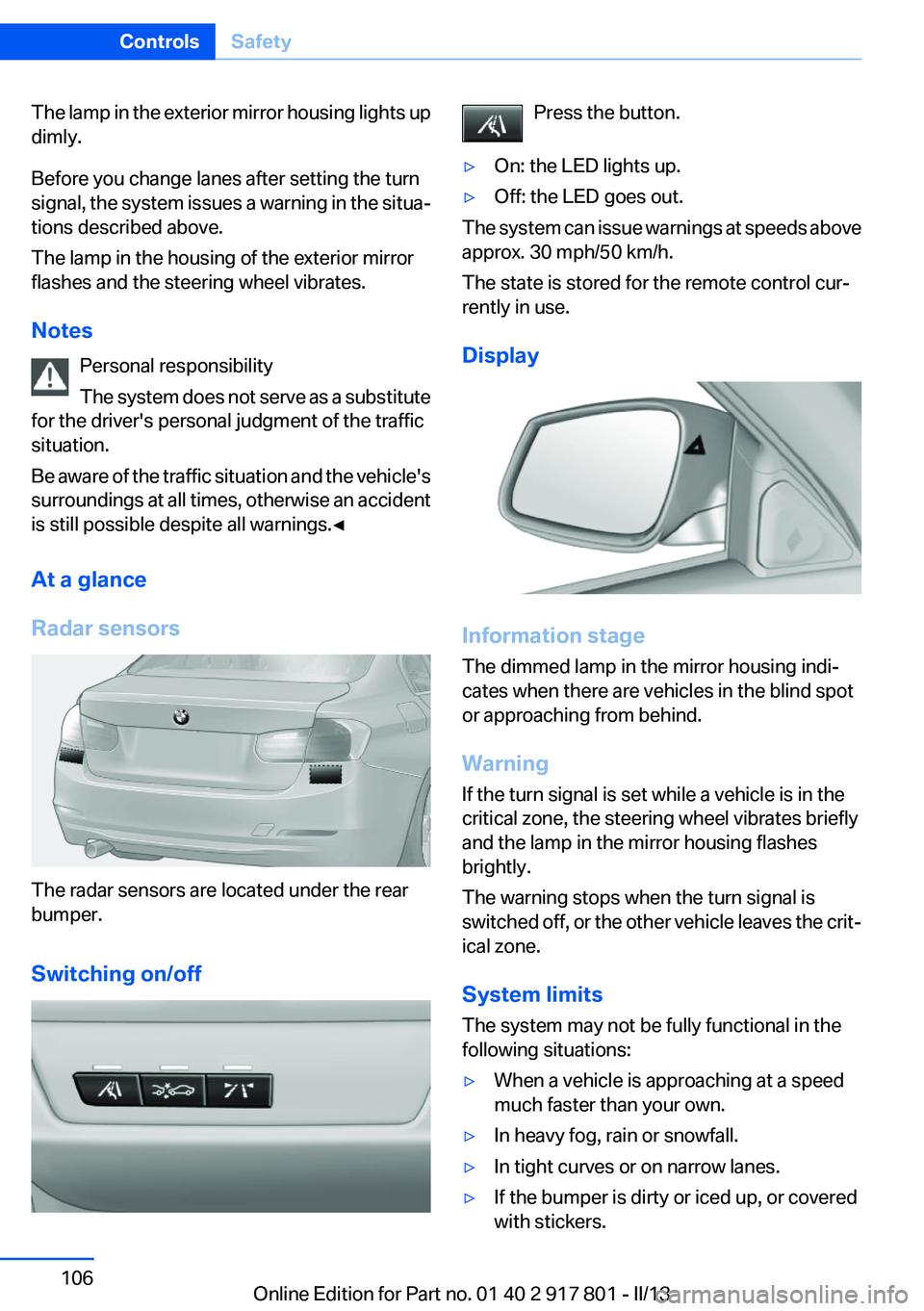
The lamp in the exterior mirror housing lights up
dimly.
Before you change lanes after setting the turn
signal, the system issues a warning in the situa‚Äź
tions described above.
The lamp in the housing of the exterior mirror
flashes and the steering wheel vibrates.
Notes Personal responsibility
The system does not serve as a substitute
for the driver's personal judgment of the traffic
situation.
Be aware of the traffic situation and the vehicle's
surroundings at all times, otherwise an accident
is still possible despite all warnings.‚óÄ
At a glance
Radar sensors
The radar sensors are located under the rear
bumper.
Switching on/off
Press the button.‚Ė∑On: the LED lights up.‚Ė∑Off: the LED goes out.
The system can issue warnings at speeds above
approx. 30 mph/50 km/h.
The state is stored for the remote control cur‚Äź
rently in use.
Display
Information stage
The dimmed lamp in the mirror housing indi‚Äź
cates when there are vehicles in the blind spot
or approaching from behind.
Warning
If the turn signal is set while a vehicle is in the
critical zone, the steering wheel vibrates briefly
and the lamp in the mirror housing flashes
brightly.
The warning stops when the turn signal is
switched off, or the other vehicle leaves the crit‚Äź
ical zone.
System limits
The system may not be fully functional in the
following situations:
‚Ė∑When a vehicle is approaching at a speed
much faster than your own.‚Ė∑In heavy fog, rain or snowfall.‚Ė∑In tight curves or on narrow lanes.‚Ė∑If the bumper is dirty or iced up, or covered
with stickers.Seite 106ControlsSafety106
Online Edition for Part no. 01 40 2 917 801 - II/13
Page 115 of 242
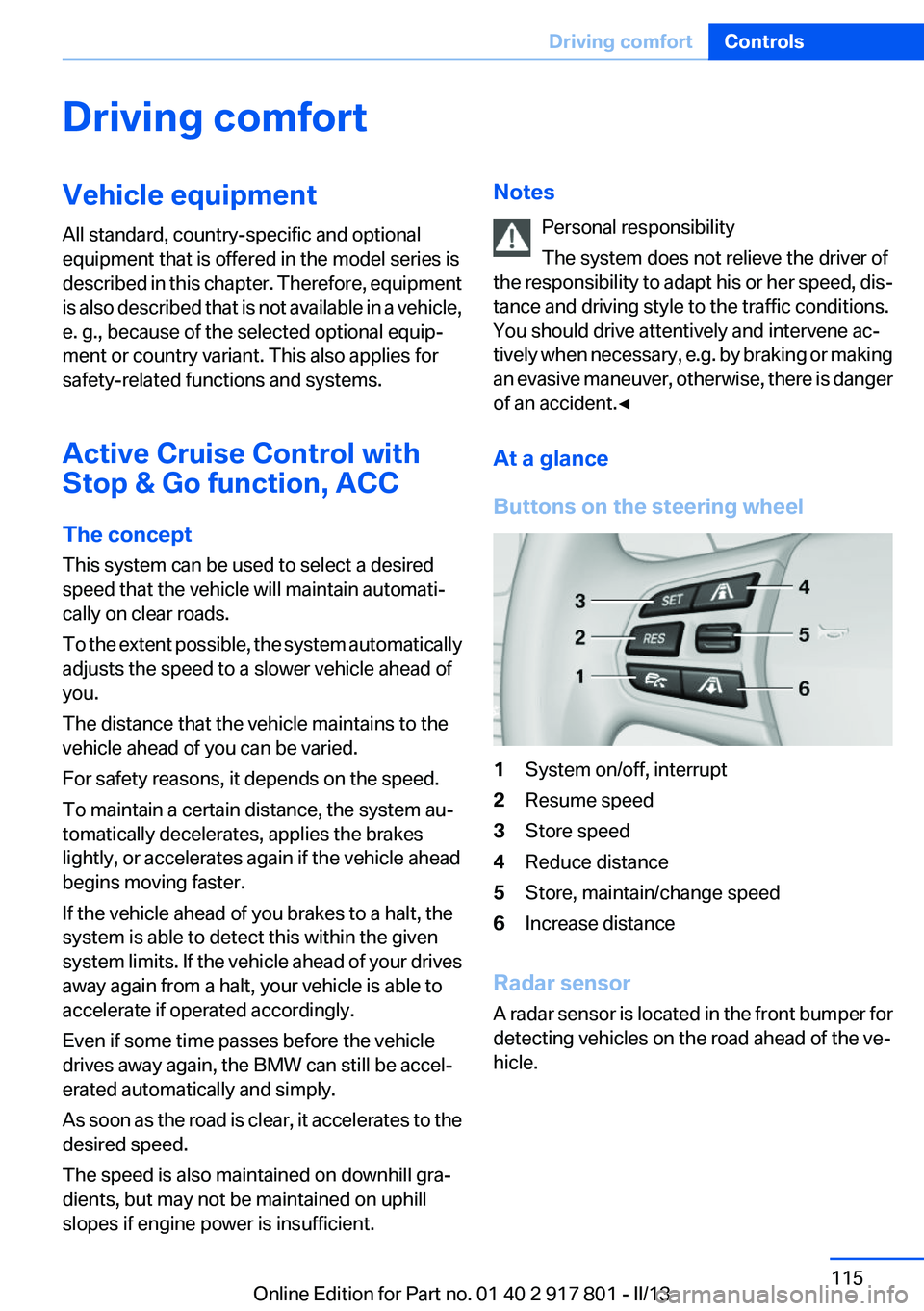
Driving comfortVehicle equipment
All standard, country-specific and optional
equipment that is offered in the model series is
described in this chapter. Therefore, equipment
is also described that is not available in a vehicle,
e. g., because of the selected optional equip‚Äź
ment or country variant. This also applies for
safety-related functions and systems.
Active Cruise Control with
Stop & Go function, ACC
The concept
This system can be used to select a desired
speed that the vehicle will maintain automati‚Äź
cally on clear roads.
To the extent possible, the system automatically
adjusts the speed to a slower vehicle ahead of
you.
The distance that the vehicle maintains to the
vehicle ahead of you can be varied.
For safety reasons, it depends on the speed.
To maintain a certain distance, the system au‚Äź
tomatically decelerates, applies the brakes
lightly, or accelerates again if the vehicle ahead
begins moving faster.
If the vehicle ahead of you brakes to a halt, the
system is able to detect this within the given
system limits. If the vehicle ahead of your drives
away again from a halt, your vehicle is able to
accelerate if operated accordingly.
Even if some time passes before the vehicle
drives away again, the BMW can still be accel‚Äź
erated automatically and simply.
As soon as the road is clear, it accelerates to the
desired speed.
The speed is also maintained on downhill gra‚Äź
dients, but may not be maintained on uphill
slopes if engine power is insufficient.Notes
Personal responsibility
The system does not relieve the driver of
the responsibility to adapt his or her speed, dis‚Äź
tance and driving style to the traffic conditions.
You should drive attentively and intervene ac‚Äź
tively when necessary, e.g. by braking or making
an evasive maneuver, otherwise, there is danger
of an accident.‚óÄ
At a glance
Buttons on the steering wheel1System on/off, interrupt2Resume speed3Store speed4Reduce distance5Store, maintain/change speed6Increase distance
Radar sensor
A radar sensor is located in the front bumper for
detecting vehicles on the road ahead of the ve‚Äź
hicle.
Seite 115Driving comfortControls115
Online Edition for Part no. 01 40 2 917 801 - II/13
Page 116 of 242
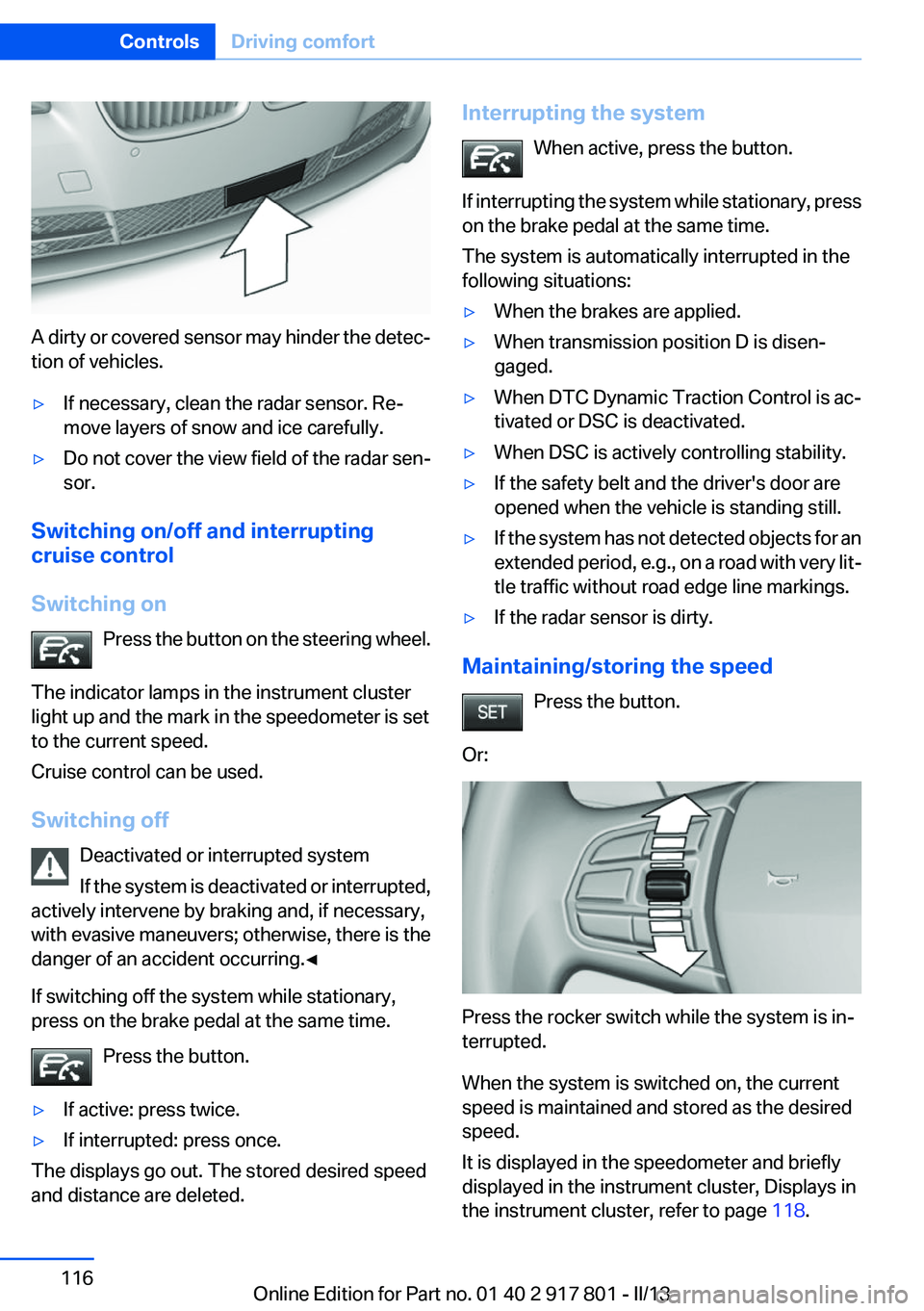
A dirty or covered sensor may hinder the detec‚Äź
tion of vehicles.
‚Ė∑If necessary, clean the radar sensor. Re‚Äź
move layers of snow and ice carefully.‚Ė∑Do not cover the view field of the radar sen‚Äź
sor.
Switching on/off and interrupting
cruise control
Switching on Press the button on the steering wheel.
The indicator lamps in the instrument cluster
light up and the mark in the speedometer is set
to the current speed.
Cruise control can be used.
Switching off Deactivated or interrupted system
If the system is deactivated or interrupted,
actively intervene by braking and, if necessary,
with evasive maneuvers; otherwise, there is the
danger of an accident occurring.‚óÄ
If switching off the system while stationary,
press on the brake pedal at the same time.
Press the button.
‚Ė∑If active: press twice.‚Ė∑If interrupted: press once.
The displays go out. The stored desired speed
and distance are deleted.
Interrupting the system
When active, press the button.
If interrupting the system while stationary, press
on the brake pedal at the same time.
The system is automatically interrupted in the
following situations:‚Ė∑When the brakes are applied.‚Ė∑When transmission position D is disen‚Äź
gaged.‚Ė∑When DTC Dynamic Traction Control is ac‚Äź
tivated or DSC is deactivated.‚Ė∑When DSC is actively controlling stability.‚Ė∑If the safety belt and the driver's door are
opened when the vehicle is standing still.‚Ė∑If the system has not detected objects for an
extended period, e.g., on a road with very lit‚Äź
tle traffic without road edge line markings.‚Ė∑If the radar sensor is dirty.
Maintaining/storing the speed
Press the button.
Or:
Press the rocker switch while the system is in‚Äź
terrupted.
When the system is switched on, the current
speed is maintained and stored as the desired
speed.
It is displayed in the speedometer and briefly
displayed in the instrument cluster, Displays in
the instrument cluster, refer to page 118.
Seite 116ControlsDriving comfort116
Online Edition for Part no. 01 40 2 917 801 - II/13
Page 118 of 242
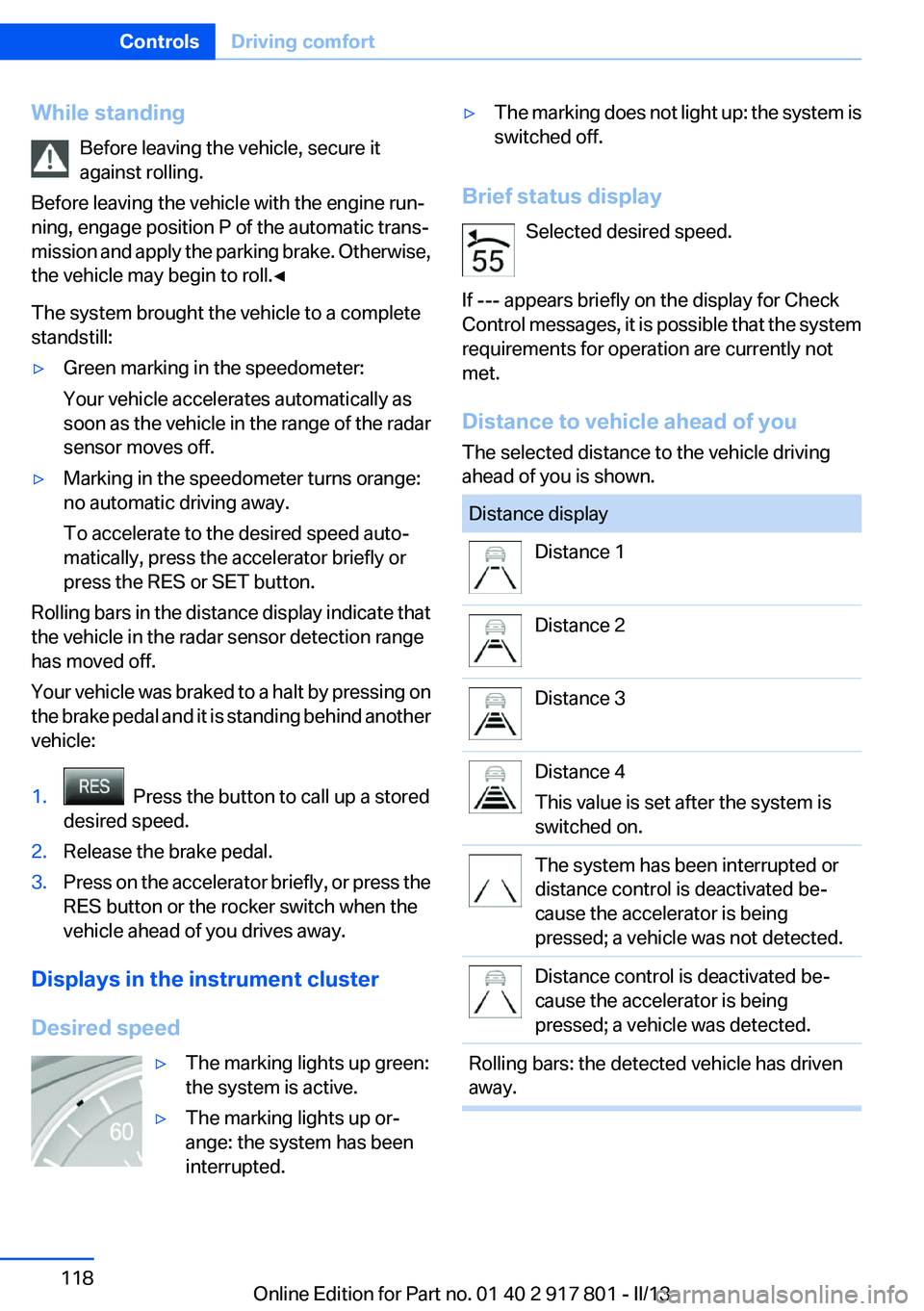
While standingBefore leaving the vehicle, secure it
against rolling.
Before leaving the vehicle with the engine run‚Äź
ning, engage position P of the automatic trans‚Äź
mission and apply the parking brake. Otherwise,
the vehicle may begin to roll.‚óÄ
The system brought the vehicle to a complete
standstill:‚Ė∑Green marking in the speedometer:
Your vehicle accelerates automatically as
soon as the vehicle in the range of the radar
sensor moves off.‚Ė∑Marking in the speedometer turns orange:
no automatic driving away.
To accelerate to the desired speed auto‚Äź
matically, press the accelerator briefly or
press the RES or SET button.
Rolling bars in the distance display indicate that
the vehicle in the radar sensor detection range
has moved off.
Your vehicle was braked to a halt by pressing on
the brake pedal and it is standing behind another
vehicle:
1. Press the button to call up a stored
desired speed.2.Release the brake pedal.3.Press on the accelerator briefly, or press the
RES button or the rocker switch when the
vehicle ahead of you drives away.
Displays in the instrument cluster
Desired speed
‚Ė∑The marking lights up green:
the system is active.‚Ė∑The marking lights up or‚Äź
ange: the system has been
interrupted.‚Ė∑The marking does not light up: the system is
switched off.
Brief status display
Selected desired speed.
If --- appears briefly on the display for Check
Control messages, it is possible that the system
requirements for operation are currently not
met.
Distance to vehicle ahead of you
The selected distance to the vehicle driving
ahead of you is shown.
Distance displayDistance 1Distance 2Distance 3Distance 4
This value is set after the system is
switched on.The system has been interrupted or
distance control is deactivated be‚Äź
cause the accelerator is being
pressed; a vehicle was not detected.Distance control is deactivated be‚Äź
cause the accelerator is being
pressed; a vehicle was detected.Rolling bars: the detected vehicle has driven
away.Seite 118ControlsDriving comfort118
Online Edition for Part no. 01 40 2 917 801 - II/13
Page 121 of 242
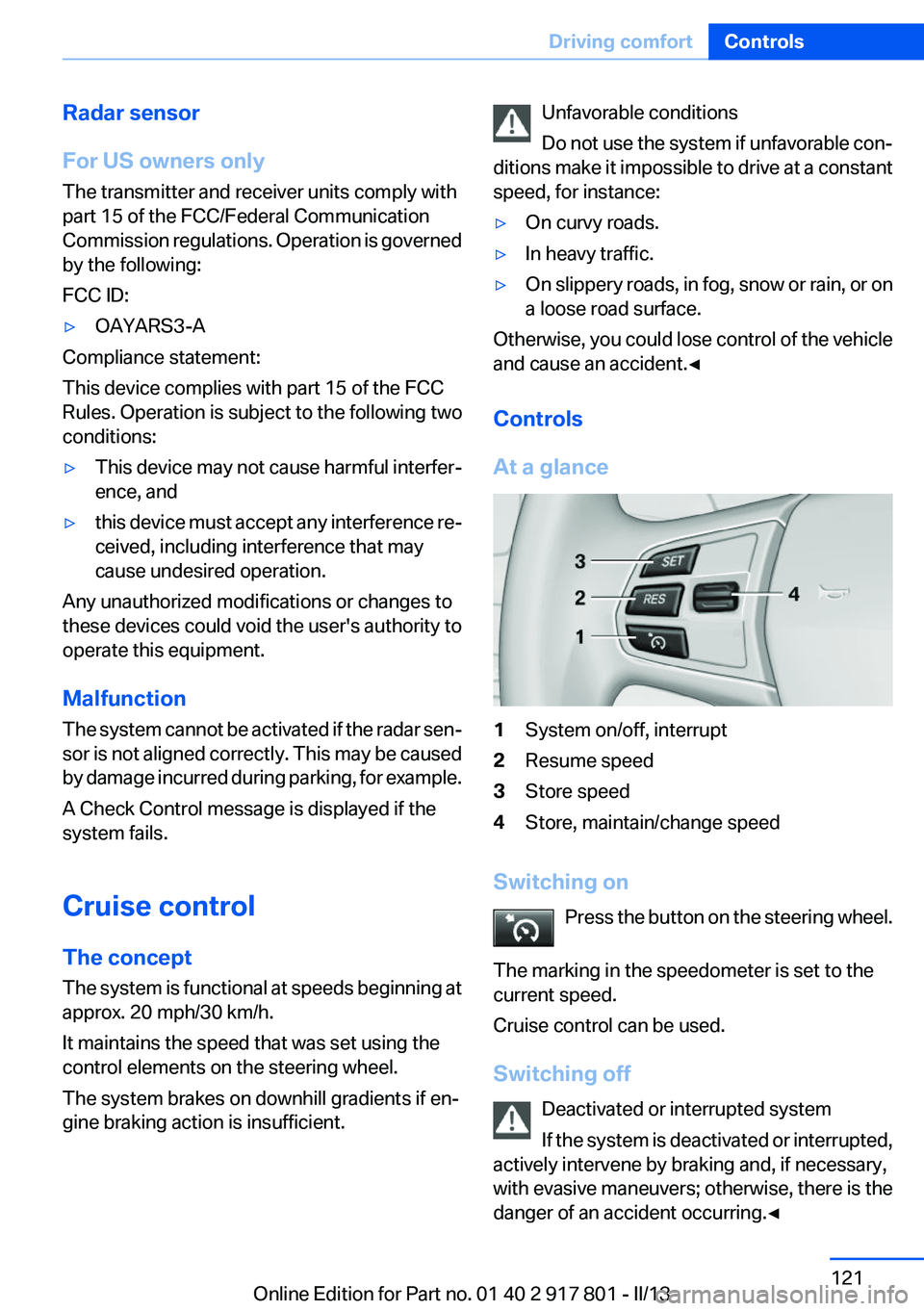
Radar sensor
For US owners only
The transmitter and receiver units comply with
part 15 of the FCC/Federal Communication
Commission regulations. Operation is governed
by the following:
FCC ID:‚Ė∑OAYARS3-A
Compliance statement:
This device complies with part 15 of the FCC
Rules. Operation is subject to the following two
conditions:
‚Ė∑This device may not cause harmful interfer‚Äź
ence, and‚Ė∑this device must accept any interference re‚Äź
ceived, including interference that may
cause undesired operation.
Any unauthorized modifications or changes to
these devices could void the user's authority to
operate this equipment.
Malfunction
The system cannot be activated if the radar sen‚Äź
sor is not aligned correctly. This may be caused
by damage incurred during parking, for example.
A Check Control message is displayed if the
system fails.
Cruise control
The concept
The system is functional at speeds beginning at
approx. 20 mph/30 km/h.
It maintains the speed that was set using the
control elements on the steering wheel.
The system brakes on downhill gradients if en‚Äź
gine braking action is insufficient.
Unfavorable conditions
Do not use the system if unfavorable con‚Äź
ditions make it impossible to drive at a constant
speed, for instance:‚Ė∑On curvy roads.‚Ė∑In heavy traffic.‚Ė∑On slippery roads, in fog, snow or rain, or on
a loose road surface.
Otherwise, you could lose control of the vehicle
and cause an accident.‚óÄ
Controls
At a glance
1System on/off, interrupt2Resume speed3Store speed4Store, maintain/change speed
Switching on Press the button on the steering wheel.
The marking in the speedometer is set to the
current speed.
Cruise control can be used.
Switching off Deactivated or interrupted system
If the system is deactivated or interrupted,
actively intervene by braking and, if necessary,
with evasive maneuvers; otherwise, there is the
danger of an accident occurring.‚óÄ
Seite 121Driving comfortControls121
Online Edition for Part no. 01 40 2 917 801 - II/13
Page 123 of 242
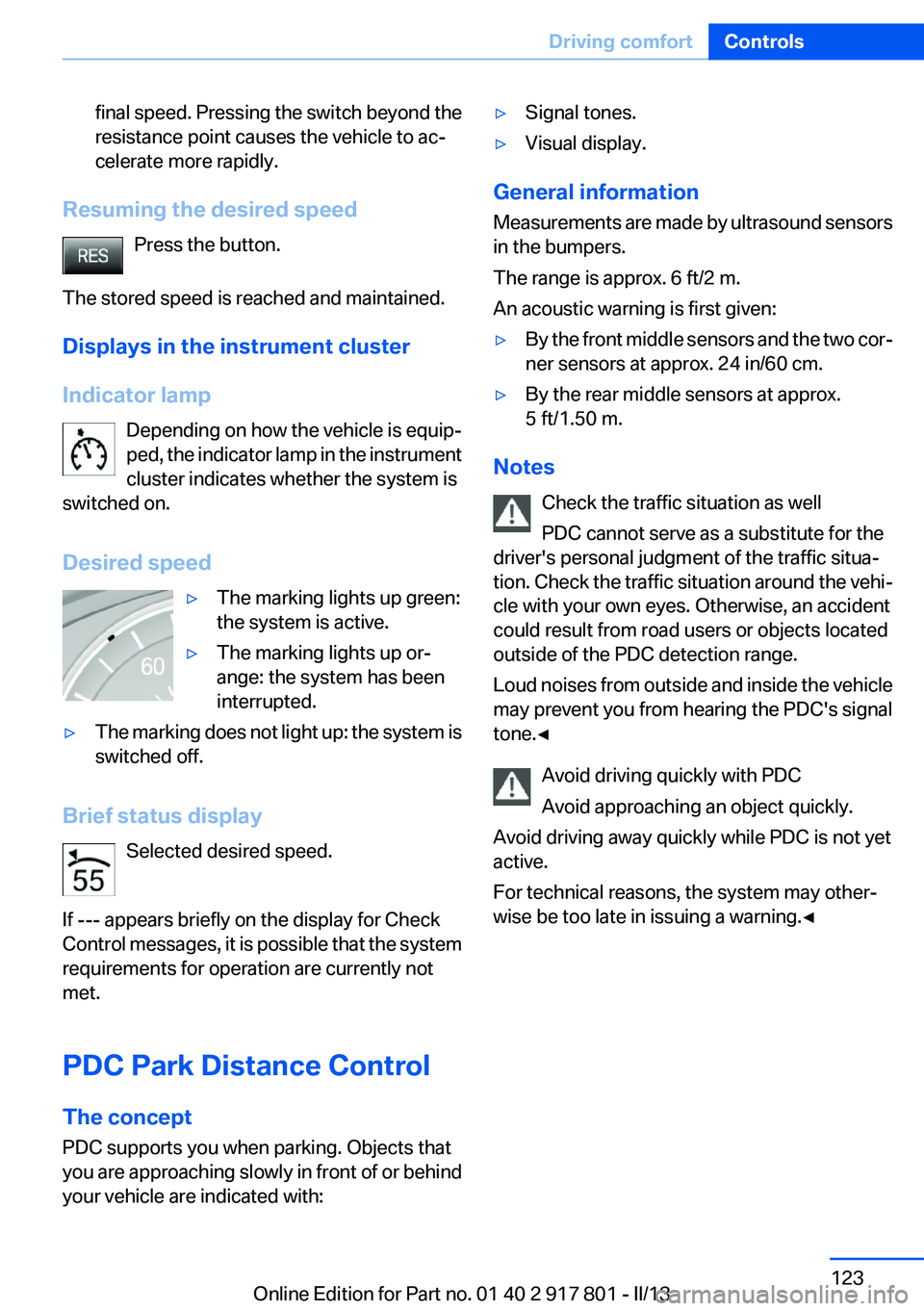
final speed. Pressing the switch beyond the
resistance point causes the vehicle to ac‚Äź
celerate more rapidly.
Resuming the desired speed
Press the button.
The stored speed is reached and maintained.
Displays in the instrument cluster
Indicator lamp Depending on how the vehicle is equip‚Äź
ped, the indicator lamp in the instrument
cluster indicates whether the system is
switched on.
Desired speed
‚Ė∑The marking lights up green:
the system is active.‚Ė∑The marking lights up or‚Äź
ange: the system has been
interrupted.‚Ė∑The marking does not light up: the system is
switched off.
Brief status display
Selected desired speed.
If --- appears briefly on the display for Check
Control messages, it is possible that the system
requirements for operation are currently not
met.
PDC Park Distance Control
The concept
PDC supports you when parking. Objects that
you are approaching slowly in front of or behind
your vehicle are indicated with:
‚Ė∑Signal tones.‚Ė∑Visual display.
General information
Measurements are made by ultrasound sensors
in the bumpers.
The range is approx. 6 ft/2 m.
An acoustic warning is first given:
‚Ė∑By the front middle sensors and the two cor‚Äź
ner sensors at approx. 24 in/60 cm.‚Ė∑By the rear middle sensors at approx.
5 ft/1.50 m.
Notes
Check the traffic situation as well
PDC cannot serve as a substitute for the
driver's personal judgment of the traffic situa‚Äź
tion. Check the traffic situation around the vehi‚Äź
cle with your own eyes. Otherwise, an accident
could result from road users or objects located
outside of the PDC detection range.
Loud noises from outside and inside the vehicle
may prevent you from hearing the PDC's signal
tone.‚óÄ
Avoid driving quickly with PDC
Avoid approaching an object quickly.
Avoid driving away quickly while PDC is not yet
active.
For technical reasons, the system may other‚Äź
wise be too late in issuing a warning.‚óÄ
Seite 123Driving comfortControls123
Online Edition for Part no. 01 40 2 917 801 - II/13
Page 125 of 242
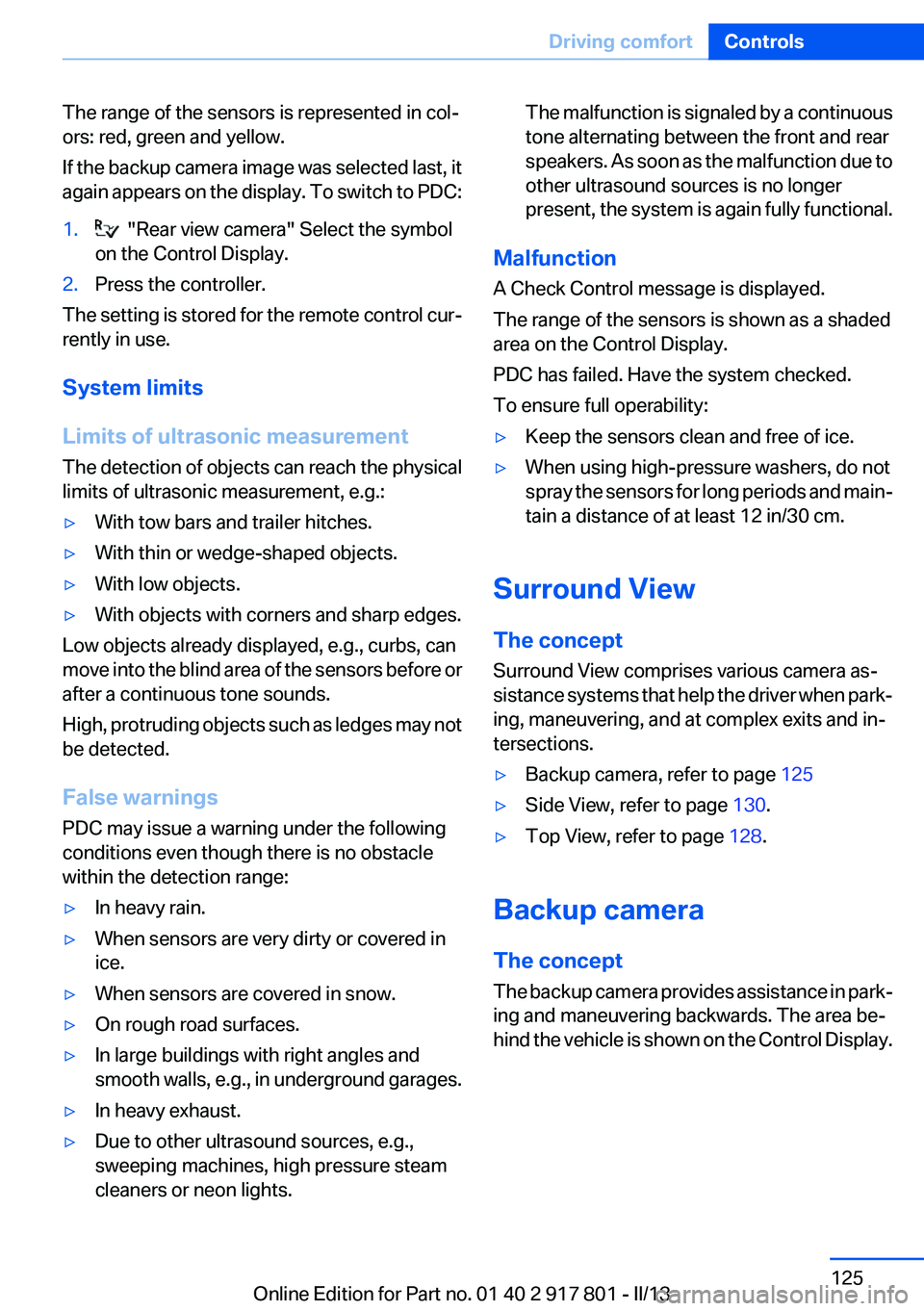
The range of the sensors is represented in col‚Äź
ors: red, green and yellow.
If the backup camera image was selected last, it
again appears on the display. To switch to PDC:1. "Rear view camera" Select the symbol
on the Control Display.2.Press the controller.
The setting is stored for the remote control cur‚Äź
rently in use.
System limits
Limits of ultrasonic measurement
The detection of objects can reach the physical
limits of ultrasonic measurement, e.g.:
‚Ė∑With tow bars and trailer hitches.‚Ė∑With thin or wedge-shaped objects.‚Ė∑With low objects.‚Ė∑With objects with corners and sharp edges.
Low objects already displayed, e.g., curbs, can
move into the blind area of the sensors before or
after a continuous tone sounds.
High, protruding objects such as ledges may not
be detected.
False warnings
PDC may issue a warning under the following
conditions even though there is no obstacle
within the detection range:
‚Ė∑In heavy rain.‚Ė∑When sensors are very dirty or covered in
ice.‚Ė∑When sensors are covered in snow.‚Ė∑On rough road surfaces.‚Ė∑In large buildings with right angles and
smooth walls, e.g., in underground garages.‚Ė∑In heavy exhaust.‚Ė∑Due to other ultrasound sources, e.g.,
sweeping machines, high pressure steam
cleaners or neon lights.The malfunction is signaled by a continuous
tone alternating between the front and rear
speakers. As soon as the malfunction due to
other ultrasound sources is no longer
present, the system is again fully functional.
Malfunction
A Check Control message is displayed.
The range of the sensors is shown as a shaded
area on the Control Display.
PDC has failed. Have the system checked.
To ensure full operability:
‚Ė∑Keep the sensors clean and free of ice.‚Ė∑When using high-pressure washers, do not
spray the sensors for long periods and main‚Äź
tain a distance of at least 12 in/30 cm.
Surround View
The concept
Surround View comprises various camera as‚Äź
sistance systems that help the driver when park‚Äź
ing, maneuvering, and at complex exits and in‚Äź
tersections.
‚Ė∑Backup camera, refer to page 125‚Ė∑Side View, refer to page 130.‚Ė∑Top View, refer to page 128.
Backup camera
The concept
The backup camera provides assistance in park‚Äź
ing and maneuvering backwards. The area be‚Äź
hind the vehicle is shown on the Control Display.
Seite 125Driving comfortControls125
Online Edition for Part no. 01 40 2 917 801 - II/13
Page 132 of 242
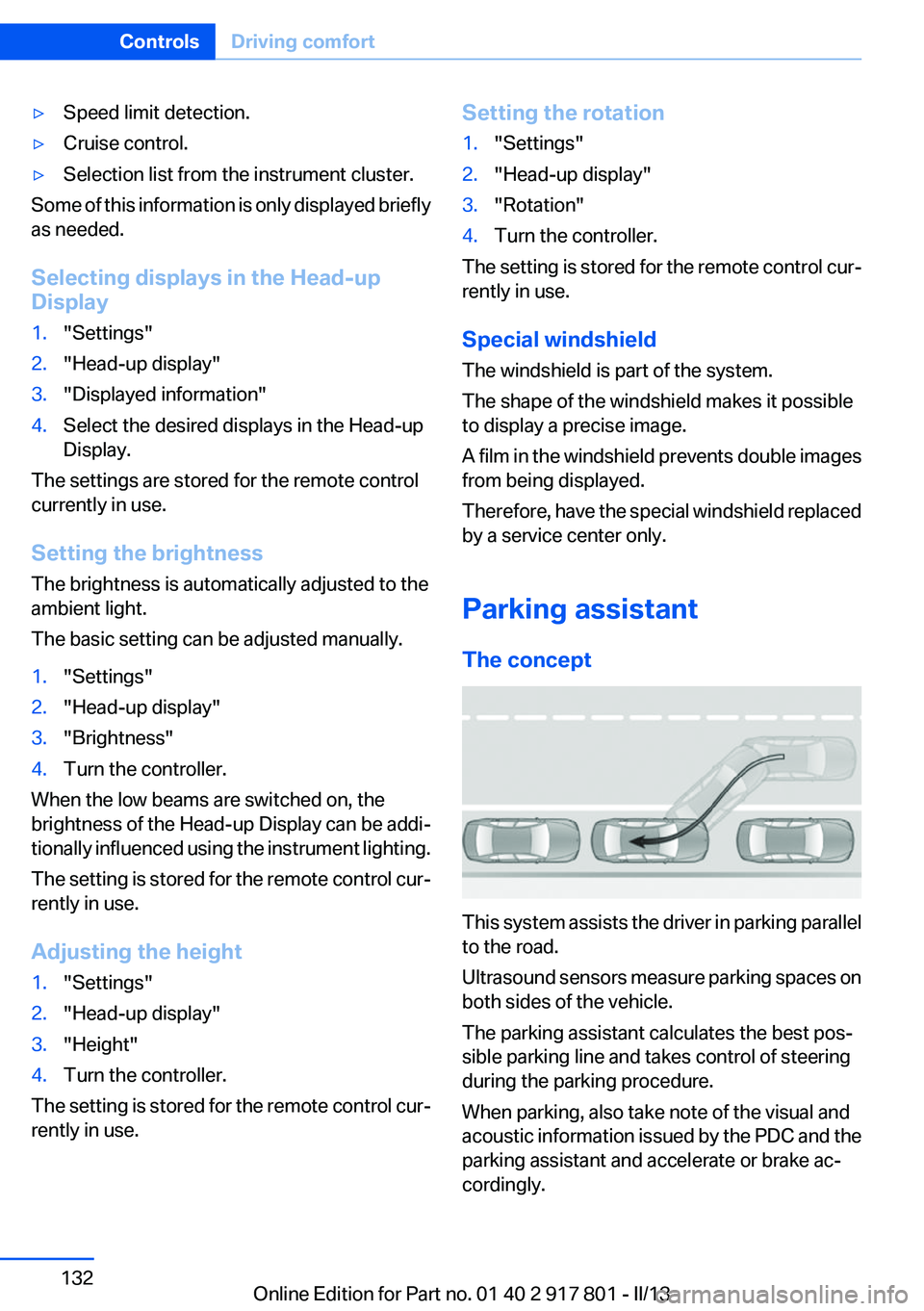
‚Ė∑Speed limit detection.‚Ė∑Cruise control.‚Ė∑Selection list from the instrument cluster.
Some of this information is only displayed briefly
as needed.
Selecting displays in the Head-up
Display
1."Settings"2."Head-up display"3."Displayed information"4.Select the desired displays in the Head-up
Display.
The settings are stored for the remote control
currently in use.
Setting the brightness
The brightness is automatically adjusted to the
ambient light.
The basic setting can be adjusted manually.
1."Settings"2."Head-up display"3."Brightness"4.Turn the controller.
When the low beams are switched on, the
brightness of the Head-up Display can be addi‚Äź
tionally influenced using the instrument lighting.
The setting is stored for the remote control cur‚Äź
rently in use.
Adjusting the height
1."Settings"2."Head-up display"3."Height"4.Turn the controller.
The setting is stored for the remote control cur‚Äź
rently in use.
Setting the rotation1."Settings"2."Head-up display"3."Rotation"4.Turn the controller.
The setting is stored for the remote control cur‚Äź
rently in use.
Special windshield
The windshield is part of the system.
The shape of the windshield makes it possible
to display a precise image.
A film in the windshield prevents double images
from being displayed.
Therefore, have the special windshield replaced
by a service center only.
Parking assistant
The concept
This system assists the driver in parking parallel
to the road.
Ultrasound sensors measure parking spaces on
both sides of the vehicle.
The parking assistant calculates the best pos‚Äź
sible parking line and takes control of steering
during the parking procedure.
When parking, also take note of the visual and
acoustic information issued by the PDC and the
parking assistant and accelerate or brake ac‚Äź
cordingly.
Seite 132ControlsDriving comfort132
Online Edition for Part no. 01 40 2 917 801 - II/13